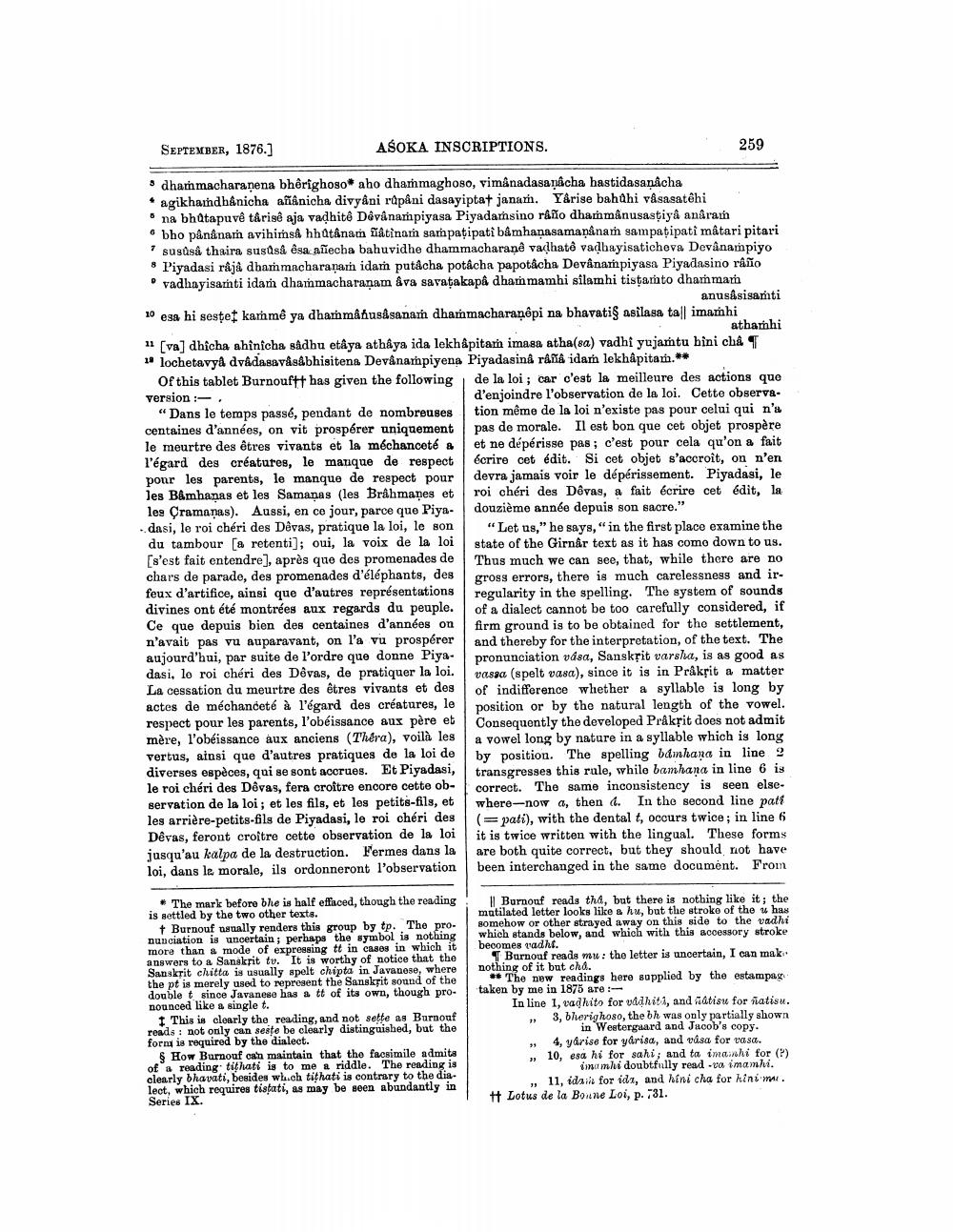________________
SEPTEMBER, 1876.]
ASOKA INSCRIPTIONS.
259
• dhammacharanena bhêrighoso aho dhammaghoso, vimânadasanâcha hastidasanacha • agikhandbânicha afiânicha divyâni rupâni dasayiptat janam. Yârise bahůhi vâsasatehi ona bhatapuvê târise aja vadhitê Dêvånampiyasa Piyadarsino råño dhammânusastiyâ anaran • bho pânânam avihimså hhatanam Tâtinar sampaţipati båmhanasamananam sampaţipati mâtari pitari
susùså thaira susdså sa aliecha bahuvidhe dhammacharanê vadhatê vadbayisatichova Devânampiyo * Piyadasi råjà dhammacharanam idam putâcha potâcha papotacha Devânampiyasa Piyadasino ráo vadhayisamti idam dhammacharanam ava savatakapâ dhammamhi silamhi tistato dhammam
anusâsisanti 10 esa hi sestet kammê ya dharmânusâ sanam dhammacharaņēpi na bhavati asilasa ta imamhi
atharnhi 11 [va] dhicha ahînicha sådhu etâya athấya ida lekh âpitam imasa atha(sa) vadhi yujamtu bini cha 1 lochetavyå dvadasavåsábhisitena Devånampiyena Piyadasina raña idam lekhâpitam.**
of this tablet Burnoufft has given the following de la loi ; car c'est la meilleure des actions que version :
d'enjoindre l'observation de la loi. Cette observa. “Dans le temps passé, pendant de nombreusestion même de la loi n'existe pas pour celui qui n'a centaines d'années, on vit prospérer uniquement pas de morale. Il est bon que cet objet prospère le meurtre des êtres vivants et la méchanceté a et ne dépérisse pas; c'est pour cela qu'on a fait l'égard des créatures, le manque de respect écrire cet édit. Si cet objet s'accroît, on n'en pour les parents, le manque de respect pour devra jamais voir le dépérissement. Piyadasi, le les B&mhanas et les Samanas (les Brahmanes et roi chéri des Dêvas, a fait écrire cet édit, la les Cramanas). Aussi, en ce jour, parce que Piya- douzième année depuis son sacro." dasi, le roi chéri des Dévas, pratique la loi, le son "Let us," he says," in the first place examine the du tambour [a retenti]; oui, la voix de la loi state of the Girnar text as it has come down to us. [s'est fait entendre), après que des promenades de Thus much we can see, that, while there are no chars de parade, des promenades d'éléphants, des gross errors, there is much carelessness and ir. feux d'artifice, ainsi que d'autres représentations regularity in the spelling. The system of sounds divines ont été montrées aux regards du peuple. of a dialect cannot be too carefully considered, if Ce que depuis bien des centaines d'années on firm ground is to be obtained for the settlement, n'avait pas vu auparavant, on l'a vu prospérer and thereby for the interpretation of the text. The aujourd'hui, par suite de l'ordre que donne Piya. pronunciation vása, Sanskřit varsa, is as good as dasi. lo roi chéri des Dévas, de pratiquer la loi. vasga (spelt vasa), since it is in Prakrit a matter La cessation du meurtre des êtres vivants et des
of indifference whether a syllable is long by actes de méchanceté à l'égard des créatures, le
position or by the natural length of the vowel. respect pour les parents, l'obéissance aux père et Consequently the developed Prakrit does not admit mère, l'obéissance aux anciens (Thera), voilà lesa vowel long by nature in a syllable which is long vertus, ainsi que d'autres pratiques de la loi de
by position. The spelling bdihana in line 2 diverses espèces, qui se sont accrues. Et Piyadasi, transgresses this rule, while bamhana in line 6 is le roi chéri des Dôvas, fera croître encore cette ob- correct. The same inconsistency is seen else. servation de la loi ; et les fils, et les petits-fils, et where-now a, then 1. In tho second line pats les arrière-petits-fils de Piyadasi, le roi chéri des (= pati), with the dental t, occurs twice; in line 6 Dêras, feront croître cette observation de la loi it is twice written with the lingual. These forms jusqu'au kalpa de la destruction. Fermes dans la are both quite correct, but they should not have loi, dans le morale, ils ordonneront l'observation been interchanged in the same document. From
• The mark before bhe is half effaced, though the reading is settled by the two other texts.
Burnouf nsnally renders this group by tp. The pro. nunciation is uncertain ; perhaps the symbol is nothing more than & mode of expressing tt in cases in which it answers to a Sanskrit tu. It is worthy of notice that the Sanskrit chitta is usually spelt chipta in Javanese, where the pt is merely used to represent the Sanskrit sound of the double t since Javanese has att of its own, though pronounced like a single t.
I This is clearly the reading, and not sette as Burnouf reads : not only can sešte be clearly distinguished, but the form is required by the dialect.
How Burnouf can maintain that the facsimile admita of a reading tighati is to me a riddle. The reading is clearly bhavati, besides wl.ch tithati is contrary to the dialect, which requires tistati, as may be seen abundantly in Series IX.
|| Burnouf reads tha, but there is nothing like it; the matilated letter looks like a hu, but the stroke of the has somehow or other strayed away on this side to the vadhi which stands below, and which with this accessory stroke becomes tadhi.
Burnouf reads wu: the letter is uncertain, I can mak. nothing of it but cha.
* The new readings here supplied by the estampas taken by me in 1875 are : In line 1, vadhito for vadhiti, and natisu for fatisu.
3, blerighoso, the bh was only partially shown
in Westergaard and Jacob's copy. . 4, yarise for yârisa, and rúsa for vasa. > 10, esa hi for sahi; and ta imahi for (?)
imamhi doubtfully read -ra imamhi. , 11, idsid for idr, and hini cha for kinimui. + Lotus de la Bonne Loi, p. 131.




